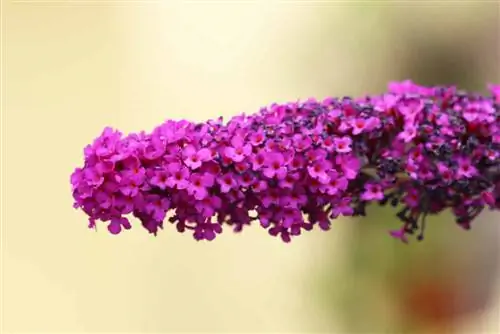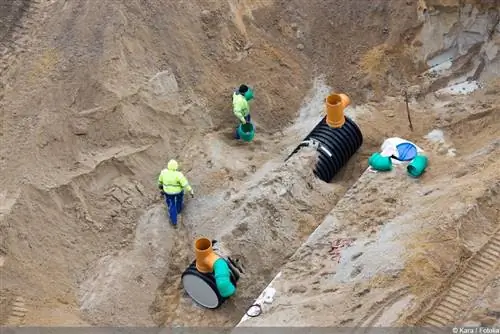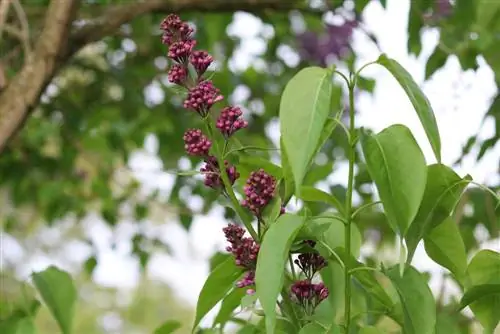- Author admin [email protected].
- Public 2023-12-17 03:39.
- Last modified 2025-06-01 06:48.
The butterfly lilac or buddleia is a flower-rich splendor that displays its beauty for a long time and not only delights people in the garden. To ensure that it stays that way, the butterfly lilac must be cut correctly. We reveal how it works in the step-by-step instructions.
When is the best time?
The best time to prune the butterfly lilac is late winter. The measure should be carried out by February at the latest on a frost-free day. If the cutting is carried out later, flowering can be significantly delayed. Especially when making radical cuts, it is important to shorten the shoots as early as possible. In this way, the buddleia still has enough time to sprout the young shoots “on time” and to bloom from around June.
Why blend?
The buddleia, botanically Buddleja davidii, is also called butterfly lilac because of its attraction to butterflies. But it only deserves this name if it also has flowers - and these only appear on annual wood. Old shoots, however, no longer produce buds.
If the trimmings are missing or left out for too long, the flowering power decreases. However, the plant itself is not damaged and is not necessarily dependent on cutting.
This makes it easy to skip the measure unless a particular abundance of flowers is desired.
Types of pruning

When it comes to butterfly lilac, there are basically three different types of cuttings. Der:
- annual pruning to stimulate flowering
- radical rejuvenation cut
- Clearing that can be done all year round
When it comes to annual pruning, which is intended to keep the flowering power as high as possible, there are two different variants. In any case, a few basic rules apply, which are also discussed in our instructions.
Annual waste - step by step
Since, as mentioned, the butterfly lilac only forms buds and flowers on annual shoots or the so-called new wood, annual cuttings are recommended to maintain a high level of flowering. To achieve particularly high flowering power and very large inflorescences, the procedure is as follows:
- In late winter, i.e. in February at the latest, all existing shoots are cut back heavily.
- With a clean cutting tool, rose or pruning shears with disinfected blades are recommended, all shoot tips are cut off individually.
- All that remains are two to four so-called eyes per stronger main shoot. The eyes are sleeping shoot buds, i.e. systems from which new branches can grow. They can usually be recognized as a thickening on a shoot.
The result should be short overall. The shoots usually differ only slightly in length and are branched two to three times, with the upper tips of these branches only being a few centimeters long. With unbranched shoots, a little more eyes or the beginning of a branch can be left in order to give the butterfly lilac a fuller, denser look later.
Note:
Cutting in this variant results in a lot of large inflorescences, but has an overall visually unfavorable effect on growth. The buddleia quickly appears gnarled and overgrown if only the young shoots are pulled.
Balancing growth
There are various options available to prevent the buddleia from blooming profusely but leaving an overall shaggy appearance. The simplest and most sensible measure, especially for older, aging or undesirably large specimens, is to first carry out a radical cut. This is similar to the annual pruning to stimulate flowering, but differs in the length of the shoots that remain. As a result, individual, older shoots can remain standing.
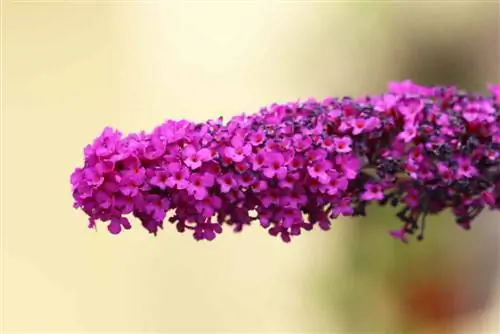
The second variant simply thins out and removes the spent panicles and trims them slightly so that Buddleja davidii does not completely lose its flowering power. So you only have to cut individual shoots at a time.
The third option is to completely suspend the offcuts now and then. This variant initially sounds less sensible if the bush already appears “overgrown”. However, this offers the opportunity to shape it better by cutting afterwards. If it is leafless in winter, annoying shoots and whorls of branches can be removed very specifically. Branches that grow as desired are only shortened by about a third of their length.
Rejuvenation cut - instructions
The rejuvenation cut is a radical pruning in which all shoots are brought to an approximately equal distance from the ground. A length of around one meter has proven successful.
Depending on the desired shape, some longer shoots are left standing after this cutting or only shortened by a third - i.e. not every two-year-old shoot is removed as far as possible. Otherwise, not only would the shape growth be impaired, but the next radical cut to rejuvenate the butterfly lilac would soon be necessary.
The rejuvenation cut on buddleia is really only necessary if:
- the flowering power decreases significantly due to many old shoots
- the shape cannot be shaped as desired even by tapering and slight shaping
- the bush grows old and bare
Note:
Even if the shrub tolerates pruning very well and in principle does not need any help to sprout again, careful care is still advisable. Following a radical rejuvenation cut, the butterfly lilac should be fertilized appropriately in spring and watered well in dry conditions so that it can recover appropriately and, above all, quickly from the cut.
Blending
No detailed instructions are necessary for printing. Only shoots that are removed are:
- are damaged
- grow crosswise or inwards
- are dead
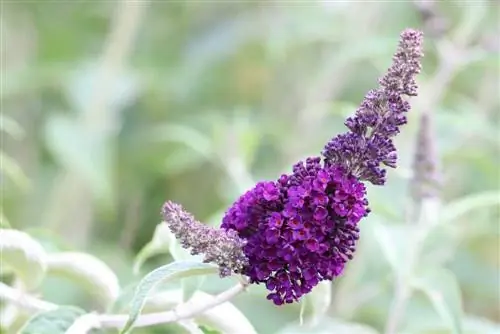
Thinning out the butterfly lilac is particularly important if all the shoots were brought to almost the same length during the annual trimming or if a radical pruning was carried out. The measure prevents the buddleia from growing too dense, bushy and gnarled.
Basic rules and errors when blending
As with any blend, there are a few points to pay attention to with buddleia. Otherwise the butterfly lilac can be damaged, become diseased or subsequently grow in an undesirable shape. The important thing is:
- clean, freshly cleaned cutting tool so as not to transmit any germs or parasites
- the appropriate cutting time between January and February on a frost-free and dry day if possible
- It's better to cut regularly than radically
- to be thinned out annually and to cut damaged shoots
- to remove the withered stands
A typical mistake is to do the cutting too late. Especially if this is more radical, i.e. shoots are severely shortened, the butterfly lilac needs a lot of time to recover and sprout. Accordingly, flowering will be delayed this year. Repeated heavy cutting is also problematic in the long run, as it strongly stimulates flowering but also causes unfavorable growth of the shoots.
Remove flowers - how and when?
Whether the spent inflorescences should be removed or not is an individual decision. It should be noted, however, that these not only have a visually disturbing effect, but that the butterfly lilac also spreads very quickly and widely via its seeds and can then become a nuisance in the garden. Among other things, the young buddleia can crowd out the native flora, which is why cutting or at least reducing the flowers makes sense.
If you want to prevent widespread spread, cut off wilted inflorescences as quickly as possible and at the latest when capsule fruits form. Cut to the next bud or leaf node.
Tip:
If seeds are to be obtained for propagation, one or two inflorescences remaining on the bush are sufficient. These in turn should be removed before the time when they are completely dry, open and spread the seeds uncontrollably. By the way, they can still do this even if they are lying loose on top of the compost, so it is better to dispose of flowers, fruits and seeds with household waste.


